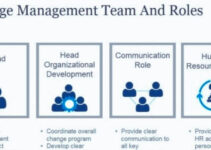Change management has become highly significant in the dynamic business environment while bringing technological transformation. Problems are bound to happen when you are implementing changes. Today, we’ll discuss change management and problem management; their definitions separately, benefits, and implementation tips for change and problem management.
What is Change Management?
Change management is the method of transitioning from the current state to the desired state. It comprises tools, processes, and strategies that allow team members and employees to explore and adopt changes; until they achieve the desired outcomes. However, some of the main key elements of change management are as follows;
- Planning and recognizing the need for change; setting goals and objectives for the change project
- Engaging with stakeholders and earning their trust and support for the change project
- Developing a communication strategy to engage, educate, and inform stakeholders
- Conducting training programs to update the skills and expertise of employees and team members
- Managing the resistance to change by comprehending its source and dealing with it accordingly
- Gathering and analyzing the feedback and making necessary adjustments
What is Problem Management?
Problem management is the method of recognizing and managing problems and issues by employing preventive practices. It also focuses on recognizing the underlying cause of the problem and taking steps to avoid it happening again. However, it allows you to avoid repetitive incidents and decreases the impact of unexpected disruption. It helps companies to recognize the root cause of the problem and take necessary preventive steps before its occurrence.
Some of the main steps involved in the process of problem management are as follows;
- Detecting and identifying the problem proactively
- Prioritizing and categorizing
- Diagnosing the cause of the problem and investigating the best solution
- Recording and documenting the problem that is triggering the incident
- Employ temporary solutions to decrease the impact of the problem and stop it from becoming an incident
Benefits of Change and Problem Management
Some of the main similarities and benefits of implementing change management and problem management; they’re as follows;
Proactive Operations & Solution
The key element of problems and change management is that they record and analyze the problem for future reference. For instance, if you have recognized the problem that has been reported before; you may have a problem that helps you to troubleshoot the issue more efficiently. If you recognize a similar incident and a longer problem, there is a probability of aggravation and resolving the problem by managing the underlying causes.
Streamlined Processes
Change management develops transparency among the team members who are executing changes in the difficult time. It promotes open communication among workers and employees; how the change project would impact their role and status; and they’re aware of it on time. However, it allows you to make adjustments in change management by developing change request forms and integrating them with automated processes.
Better User Experience
They both offer pre-defined approaches and they help users and employees to remain productive and avoid disruptions in their routine life. The main objective is to give the top priority to the employees; the teams could amplify their service level by employing smart technological tools and automation processes.
Implementation Tips for Change Management and Problem Management
Some of the main implementation tips for change and problem management processes are as follows;
Comprehending Problems
Studying and analyzing tools and metrics helps you to recognize the growing trends. If you gather and analyze reports about incidents consistently, then it allows you to perform a comprehensive root cause analysis and easily recognize the problems in the environment.
Relevant Documentation
Creating and maintaining an updated knowledge base helps team members and employees further improve their knowledge of known new errors. It allows them to quickly respond to the solution. Often, it results in the form of developing more proactive service operations that save a lot of time and resources.
Launch Change Problem Management
Problem change management strategies play a key role in making sure that the company keeps running its operations smoothly in a hybrid and complex business environment. It decreases service disruption for users who are relying on digital services.
Outline Standard & Emergency Request
There are different protocols for standard and emergency change requests. It is significant for the change request approving person; people that need to be informed, how to test the changes, and how the team would recognize the problem. The change request process would create transparency for the team members and the documentation decreases the future risk factors.
Conclusion: Change Management and Problem Management |Change and Problem Management
After an in-depth study of change management and problem management; we have realized that change and problems management have a lot of similarities. In fact, problems management is a small area and part of change management. If you are learning about change and problem management; then you should keep in mind the abovementioned implementation tips, similarities, and benefits.
Ahsan is an accomplished researcher and has a deep insight in worldly life affairs. He goes Live 3 days a week on various social media platforms. Other than research writing, he’s a very interesting person.


